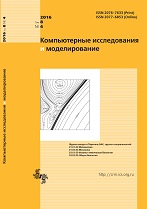|
This article is cited in 4 scientific papers (total in 4 papers)
MODELS IN PHYSICS AND TECHNOLOGY
Simulation of properties of composite materials reinforced by carbonnanotubes using perceptron complexes
S. P. Dudarov, A. N. Diev, N. A. Fedosova, E. A. Koltsova
D. Mendeleyev University of Chemical Technology of Russia, 9, Miusskaya square, Moscow, 125047, Russia
Abstract:
Use of algorithms based on neural networks can be inefficient for small amounts of experimental data. Authors consider a solution of this problem in the context of modelling of properties of ceramic composite materials reinforced with carbon nanotubes using perceptron complex. This approach allowed us to obtain a mathematical description of the object of study with a minimal amount of input data (the amount of necessary experimental samples decreased 2-3.3 times). Authors considered different versions of perceptron complex structures. They found that the most appropriate structure has perceptron complex with breakthrough of two input variables. The relative error was only 6 %. The selected perceptron complex was shown to be effective for predicting the properties of ceramic composites. The relative errors for output components were 0.3 %, 4.2 %, 0.4 %, 2.9 %, and 11.8 %.
Keywords:
neural network, perceptron complex, mathematical model, simulation, ceramic composite, carbonnanotubes, flexural strength.
Received: 07.10.2014
Revised: 03.02.2015
Citation:
S. P. Dudarov, A. N. Diev, N. A. Fedosova, E. A. Koltsova, “Simulation of properties of composite materials reinforced by carbonnanotubes using perceptron complexes”, Computer Research and Modeling, 7:2 (2015), 253–262
Linking options:
https://www.mathnet.ru/eng/crm184 https://www.mathnet.ru/eng/crm/v7/i2/p253
|

| Statistics & downloads: |
| Abstract page: | 127 | | Full-text PDF : | 71 | | References: | 33 |
|




 Contact us:
Contact us: Terms of Use
Terms of Use
 Registration to the website
Registration to the website Logotypes
Logotypes








 Citation in format
Citation in format 
